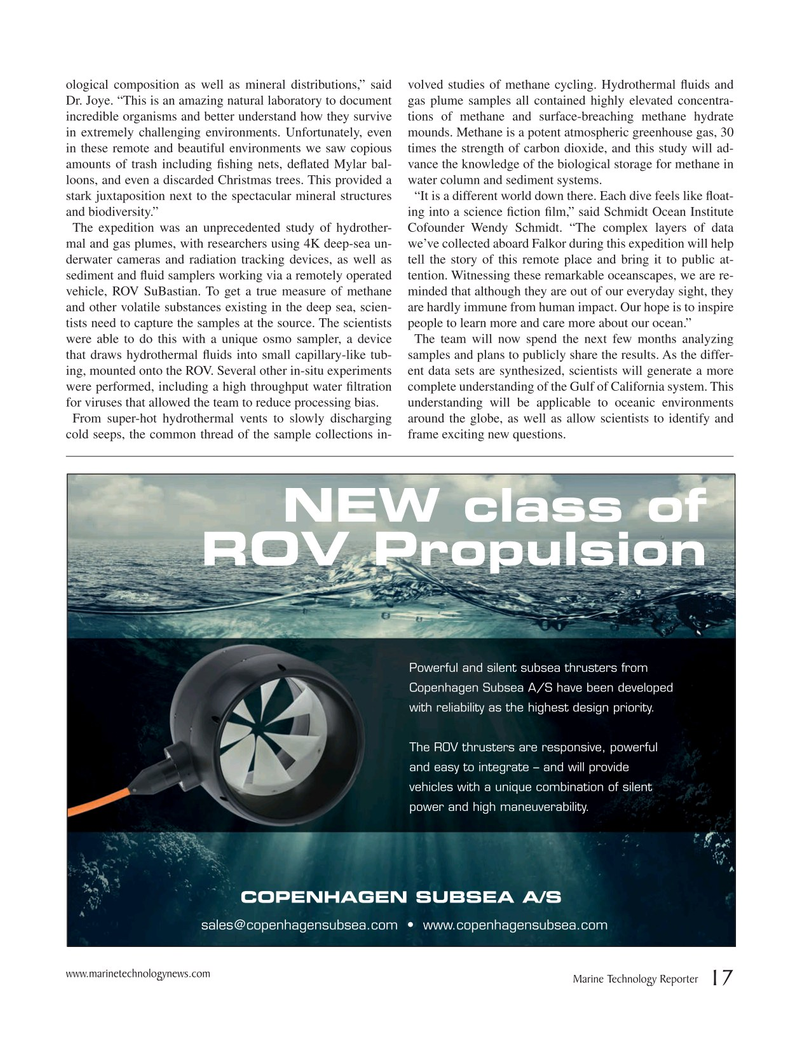
Page 17: of Marine Technology Magazine (May 2019)
Underwater Defense Technology
Read this page in Pdf, Flash or Html5 edition of May 2019 Marine Technology Magazine
ological composition as well as mineral distributions,” said volved studies of methane cycling. Hydrothermal ? uids and
Dr. Joye. “This is an amazing natural laboratory to document gas plume samples all contained highly elevated concentra- incredible organisms and better understand how they survive tions of methane and surface-breaching methane hydrate in extremely challenging environments. Unfortunately, even mounds. Methane is a potent atmospheric greenhouse gas, 30 in these remote and beautiful environments we saw copious times the strength of carbon dioxide, and this study will ad- amounts of trash including ? shing nets, de? ated Mylar bal- vance the knowledge of the biological storage for methane in loons, and even a discarded Christmas trees. This provided a water column and sediment systems.
stark juxtaposition next to the spectacular mineral structures “It is a different world down there. Each dive feels like ? oat- and biodiversity.” ing into a science ? ction ? lm,” said Schmidt Ocean Institute
The expedition was an unprecedented study of hydrother- Cofounder Wendy Schmidt. “The complex layers of data mal and gas plumes, with researchers using 4K deep-sea un- we’ve collected aboard Falkor during this expedition will help derwater cameras and radiation tracking devices, as well as tell the story of this remote place and bring it to public at- sediment and ? uid samplers working via a remotely operated tention. Witnessing these remarkable oceanscapes, we are re- vehicle, ROV SuBastian. To get a true measure of methane minded that although they are out of our everyday sight, they and other volatile substances existing in the deep sea, scien- are hardly immune from human impact. Our hope is to inspire tists need to capture the samples at the source. The scientists people to learn more and care more about our ocean.” were able to do this with a unique osmo sampler, a device The team will now spend the next few months analyzing that draws hydrothermal ? uids into small capillary-like tub- samples and plans to publicly share the results. As the differ- ing, mounted onto the ROV. Several other in-situ experiments ent data sets are synthesized, scientists will generate a more were performed, including a high throughput water ? ltration complete understanding of the Gulf of California system. This for viruses that allowed the team to reduce processing bias. understanding will be applicable to oceanic environments
From super-hot hydrothermal vents to slowly discharging around the globe, as well as allow scientists to identify and cold seeps, the common thread of the sample collections in- frame exciting new questions.
NEW class of
ROV Propulsion
Powerful and silent subsea thrusters from
Copenhagen Subsea A/S have been developed with reliability as the highest design priority.
The ROV thrusters are responsive, powerful and easy to integrate – and will provide vehicles with a unique combination of silent power and high maneuverability.
COPENHAGEN SUBSEA A/S [email protected] • www.copenhagensubsea.com www.marinetechnologynews.com
Marine Technology Reporter 17
MTR #4 (1-17).indd 17 4/25/2019 9:03:30 AM

 16
16

 18
18
